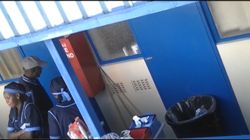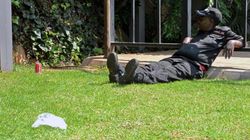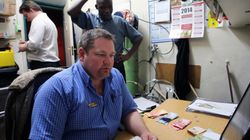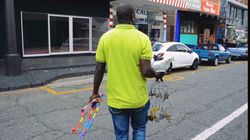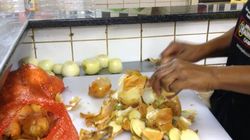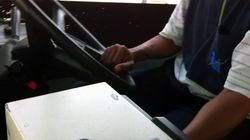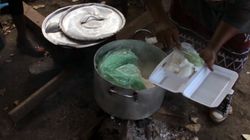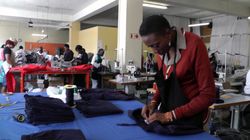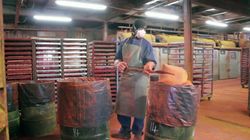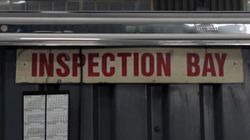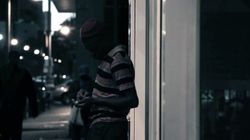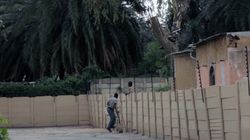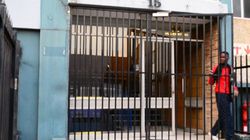Johannesburg|Süd-Afrika
Statistische Daten
Google-Einträge für Johannesburg; Joburg, Jozi 293.000.000
Google-Einträge pro Einwohner (Metropolregion) 66,12
Stadtgründung 1886
http://de.wikipedia.org/wiki/Johannesburg
BEVÖLKERUNG (2011)
City 957.441
Metropolregion 4.434.827
http://en.wikipedia.org/wiki/Johannesburg
Fläche
City 334,81 km2
Metropolregion 1.644,96 km2
http://en.wikipedia.org/wiki/Johannesburg
Bevölkerungsdichte (Einwohner/km²)
City 2.900
Metropolregion 2.700
http://en.wikipedia.org/wiki/Johannesburg
Bevölkerungsentwicklung (Metropolregion)
1996 2.638.470 [1]
2001 3.226.060 [1]
2011 4.434.830 [1]
2040 6 - 8 Mio. [2]
[1] http://www.gcro.ac.za/sites/default/files/reports/gcro_esri_conference_presentation_may_2013.pdf
[2] http://www.joburg.org.za/images/stories/2013/May/CoJ%20SITPF%20Draft%2013%20May%202013.pdf
Altersstruktur (2011)
0 - 14 23,2%
15 - 64 72,7%
65 + 4,1%
http://beta2.statssa.gov.za/?page_id=1021&id=city-of-johannesburg-municipality
Sprachen (Metropolregion, 2011)
English 19,8%
Zulu 23,1%
Afrikaans 7,2%
Xhosa 6,7%
Sepedi 7,2%
Sesotho 9,5%
Setswana 7,6%
Xitsonga 6,5%
http://beta2.statssa.gov.za/?page_id=1021&id=city-of-johannesburg-municipality
Bevölkerungsstruktur (Metropolregion, 2011)
Black African 76,4%
Coloured 5,6%
Indian / Asian 4,9%
White 12,3%
http://beta2.statssa.gov.za/?page_id=1021&id=city-of-johannesburg-municipality
KLIMA
Max. Temperatur Ø (°C) 21,9
Min. Temperatur Ø (°C) 10,1
Niederschlag / Jahr (mm) 713
Regentage 155
http://en.wikipedia.org/wiki/Johannesburg
Haushalte (Metropolregion, 2011) 1.434.856
davon mit Zugang zu
Leitungswasser im Haus 64,7%
Wasser im Hof 26,9%
Elektrizität 90,8%
ans Abwassernetz angeschlossene Toilette 87,1%
http://beta2.statssa.gov.za/?page_id=1021&id=city-of-johannesburg-municipality
Verbreitung von Gebrauchsgütern (% der Haushalte besitzen, 2011)
Handy 94,4%
Computer 33,6%
Internetzugang von zuhause oder Handy 32,5%
Fernseher 83,8%
Radio 71,4%
KFZ 38,2%
Kühlschrank 74,6%
Elektro- / Gasofen 86,8%
http://beta2.statssa.gov.za/?page_id=1021&id=city-of-johannesburg-municipality
WIRTSCHAFT
GDP (Johannesburg; 2013) 48,2 Mrd. EUR
GDP per Capita (Johannesburg; 2013) 7.729 EUR
http://www.joburg.org.za/images/stories/2014/April/idp%20doc%20final.pdf
GDP-Entwicklung (Provinz Gauteng; zu heutigen Preisen)
2003 29.3 Mrd EUR
2007 46.9 Mrd. EUR
2012 74,5 Mrd. EUR
http://beta2.statssa.gov.za/publications/P0441/P04413rdQuarter2013.pdf
Arbeitslosenrate (2011) 25%
Jugendarbeitslosigkeit 31,5%
http://beta2.statssa.gov.za/?page_id=1021&id=city-of-johannesburg-municipality
Anteile am GVA (Gross value added) nach Sektoren (Auswahl; 2010)
Finanzen und Versicherungen 12,7%
andere Dienstleistungen 9,3%
Immobilien 7,6%
Großhandel 7,1%
Einzelhandel und Reparaturen 5,6%
Baugewerbe 4,8%
Gesundheit und Soziales 4,6%
Öffentliche Verwaltung 4,2%
http://www.joburg.org.za/images/stories/2013/May/AnnualReport/annexure%20b_%20annual%20performance%20report_190213.pdf
Beschäftigte nach Sektoren (2013)
Agriculture 9.071
Mining 13.946
Manufacturing 252.977
Electricity 13.369
Construction 132.486
Trade 486.440
Transport 137.551
Finance 518.858
Community Services 367.820
Households 159.421
Total 2.091.940
http://www.joburg.org.za/images/stories/2014/feb/annexure%20b%202.pdf
Inflationsrate (2013) 5,2%
http://de.statista.com/statistik/daten/studie/254740/umfrage/inflationsrate-in-suedafrika/
Durch Streiks verlorene Arbeitstage per 1.000 Beschäftigte
Südafrika (2008 - 2012) 440 Tage
EU (2005 - 2009) 30,6 Tage
Großbritannien (2008 - 2012) 24,2 Tage
http://www.bdlive.co.za/opinion/letters/2013/11/08/letter-statistics-show-sa-leads-on-strikes
ARMUT
Haushalte unterhalb der Armutsgrenze (Johannesburg)
Haushaltseinkommen weniger als 108 EUR / Monat
2001 51,0%
2011 34,9%
Haushaltseinkommen weniger als 216 EUR/Monat
2001 66,9%
2011 51,6%
This decline can be largely attributed to the government’s social grants programme as shown by various research studies. More than 12 million South African are beneficiaries of social transfers, with 62% of grants going to 40% of the poorest households and 82% to the poorest 60% of households. It is widely documented that without social grants poverty would deepen over time rather than improve in South Africa.
http://za.boell.org/sites/default/files/hbs_urban_energy_poverty_report_final.pdf
Informelle Siedlungen 182
Bevölkerung 350.000
http://www.joburg.org.za/index.php?option=com_content&id=1949&Itemid=168
Haushalte in informellen Siedlungen
2001 212.696 = 21,1%
2011 249.823 = 17,4%
According to Misselhorn (2010), “the actual numbers of households residing in informal settlements is likely to be significantly higher than estimates by Stats SA.” Misselhorn alerts that evidence from actual research reveals that shack counts undertaken by housing officials (aerial surveys supplemented by ground surveys) are more reliable, and sometimes the discrepancy can be as high as 45 percent between Stats SA and municipal department figures. [...] Misselhorn (2010) therefore argues “...that the actual number of households living in informal settlements in South Africa is probably substantially more than the official Stats SA estimate [of approximately 1.96 million households], and that, contrary to what official estimates suggest, there has probably not been a rapid decline in numbers of households living in informal settlements in recent years...
http://za.boell.org/sites/default/files/hbs_urban_energy_poverty_report_final.pdf
VERBRECHEN
Verbrechen (Johannesburg; April 2012 - März 2013)
Morde 2.997
Versuchte Morde 12.288
Raub 35.869
Einbrüche 68.544
http://www.johannesburg.info/saps-crime-under-control/
Vergewaltigungen (Südafrika; Fiskaljahr 2012 / 2013)
angezeigte Fälle 66.000 [1]
geschätzt 120.000 [1]
Anteil Vergewaltiger an der männlichen Bevölkerung 28% - 37% [2]
Anteil Teilnehmer an Gruppenvergewaltigungen 7% - 9% [2]
[1] http://ewn.co.za/2014/01/29/Rape-stats-deceptive-due-to-under-reporting
"Rape is one of the most under-reported crimes in South Africa," noted Shukumisa, an NGO coalition. It points to research, conducted in Gauteng in 2010, that found one in four of women questioned in the study had been raped in the course of their lifetimes, while almost one in 12 had been raped in 2009. But only one in 13 women raped by a non-partner reported the incident to the police, while one in 25 of the women raped by their partner reported this to the police. Rape statistics are, therefore, badly skewed because many women remain silent about sexual violence.
[2] http://www.issafrica.org/uploads/CQ41Jewkes.pdf
Individuelles Sicherheitsgefühl (Provinz Gauteng; 2011)
Fühle mich tagsüber sicher 78%
Fühle mich bei nächtlichen Gängen sicher 30%
Fühle mich zuhause sicher 73%
schon einmal Opfer eines Verbrechens 23%
http://www.gcro.ac.za/sites/default/files/reports/gcro_overview_october_2013_low_res.pdf
LEBENSHALTUNGSKOSTEN
Durchschnittliches Jahreseinkommen (2011)
White 24.644 EUR
Indians / Asians 17.730 EUR
Coloured 9.721 EUR
Black African 4.655 EUR
http://www.joburg.org.za/images/stories/2013/June/2013-16%20idp%2017may2013%20final.pdf
Mindestlohn 0,65 EUR/h
http://www.timeslive.co.za/local/2013/11/22/new-minimum-wage-for-domestic-workers
Preise (in EUR)
12 Eier 1,34,-
1 kg Tomaten 1,08,-
Brot für 2 Personen (1 Tag) 0,64,-
0,5 Liter Bier im Supermarkt 1,26,-
1 Liter Vollmilch 0,97,-
Stundenlohn Putzhilfe 2,46,-
Monatsmiete für eine möblierte
85 qm-Wohnung in einem teuren
Stadtviertel 874,00,-
1 Liter Benzin 0,91,-
Monatskarte ÖPNV 47,00,-
http://www.expatistan.com
WOHNEN
Maboneng (City Improvement District)
2013 / geplant
Fläche ca. 1km2 [1]
Gebäudefläche 150.000m2 / 1.000.000m2 [1]
Gebäude im Besitz 37 / 50 [1]
Bewohner 500 / 3.000 [1]
Arbeitsplätze 500 / 1.500 [1]
Bäume 100 / 350 [1]
Monatsmieten 210 - 1.260 EUR [2]
Kaufpreise 27.300 - 140.000 EUR [3]
[1] http://www.mabonengprecinct.com/files/8213/7879/2928/Maboneng_Growth_Report_10-13.pdf
[2] http://mabonengcid.co.za/wp-content/uploads/2014/03/Business-Plan-Maboneng-CID-FInal-2014.pdf
[3] http://www.iol.co.za/business/news/maboneng-aims-to-house-3-000-enlightened-individuals-1.1516592
City Improvement Districts worldwide have proven to be one of the most effective and sustainable urban and place management institutions. In Johannesburg, there are 19 legislated CIDs, including areas such as Braamfontein, Main Street, Rosebank, Sandton, Newtown, all of which have experienced dramatic turnarounds and economic revival through such interventions.
http://mabonengcid.co.za/wp-content/uploads/2014/03/Business-Plan-Maboneng-CID-FInal-2014.pdf
Vor sechs Jahren hatte der heute 31-jährige Johannesburger Investor Jonathan Liebman angefangen, im bis dahin verrufenen Stadtteil Jeppestown günstig Haus um Haus zu kaufen. Seine Firma Propertuity renovierte die meist leerstehenden ehemaligen Industriegebäude und Lagerhallen, um sie dann als schicke Wohnungen, Büros, Geschäfte und Veranstaltungsorte zu vermieten oder zu verkaufen.
http://www.zeit.de/lebensart/2014-04/maboneng-johannesburg-gentrifizierung-suedafrika
Inner City Johannesburg (2011)
Leerstandsrate für Privatwohnungen 1%
billigste über Makler angebotene Wohnung (1 Zi.) 115,- EUR
Haushalte mit weniger als 217 EUR / Mt. 33.861 mit 121.899 Personen
Entspricht ca. 50% aller Haushalte in der Inner City
diese können für max. Miete aufbringen ca. 65,- EUR (= 30% des Einkommens)
http://www.seri-sa.org/images/Minding_the_Gap.pdf
Steyn City (Gated Community)
Größe 810 ha; davon die Hälfte bewaldete Parks [1]
Baukosten 420 Mio. EUR [1]
Fertigstellung 2015 [1]
Besitzer Douw Steyn [1]
Wohneinheiten 11.000 [2]
geplanzte Bäume 120.000 [3]
Kosten von Steyn Haus in Steyn City 17,5 Mio. EUR [1]
Größe des Hauses 3.000m2 [1]
[1] http://www.bdlive.co.za/business/property/2013/10/18/steyn-mansion-sets-r250m-property-record
[2] http://www.urbandynamics.co.za/index.php/latest-articles/109-steyn-city.pdf
[3] http://www.steyncity.co.za/news-room-2/
„Bad Buildings“
geschätzte Anzahl (Johannesburg; 2011) 1.380 [1]
geschätzte Anzahl (Inner city; 2005) 235 [2]
geschätzte Bevölkerung in Bad Buildings mehr als 250.000 [3]
A [bad] building is one that has deteriorated to such an extent that its market value is below the outstanding debt owed. Living conditions in the building have become extremely harmful to the occupants. The buildings are usually controlled by slumlords who overfill the flats, charge exorbitant rents and allow the buildings to become rundown...Slumlords neglect to pay the rates over to the City, and electricity and water are terminated, further jeopardising the quality of life of the tenants.
[1] http://urpl.wisc.edu/lecturers/Klug%20-%20CLTs%20in%20Jo-burg%20-%20Final-Draft-Nov2013.pdf
[2]http://wiredspace.wits.ac.za/jspui/bitstream/10539/12872/2/Cheap%20rental%20accommodation%20in%20the%20inner%20city%20of%20Johannesburg.pdf
[3] http://www.seri-sa.org/images/Minding_the_Gap.pdf
VERKEHR
Modal Split (2002)
KFZ 36,6%
zu Fuß 30,9%
Mini Bus 23,4%
Zug 4,5%
Bus 2,4%
Fahrrad 0,2%
http://www.codatu.org/wp-content/uploads/CODATU-Promotion-of-public-transport-walking-and-cycling.pdf
Kraftfahrzeuge
over a third of the 4,5 million registered cars in South Africa are driving in Johannesburg
http://www.joburg.org.za/index.php?option=com_content&id=1720&Itemid=168
Rea Vaya (Bus Rapid Transit = Bussystem auf für den übrigen Verkehr gesperrten Routen)
Streckennetz 59 km [1]
geplantes Streckennetz 330 km [3]
Stationen 48 [1]
Busse (geplant für Ende 2014) 277 [2]
tägliche Passagiere (2013) 39.000 [2]
[1] http://www.reavaya.org.za/welcome/fast-facts
[2] http://issuu.com/cojdocuments/docs/anual_report_b
[3] http://en.wikipedia.org/wiki/Implementation_of_bus_rapid_transit_by_country#South_Africa

